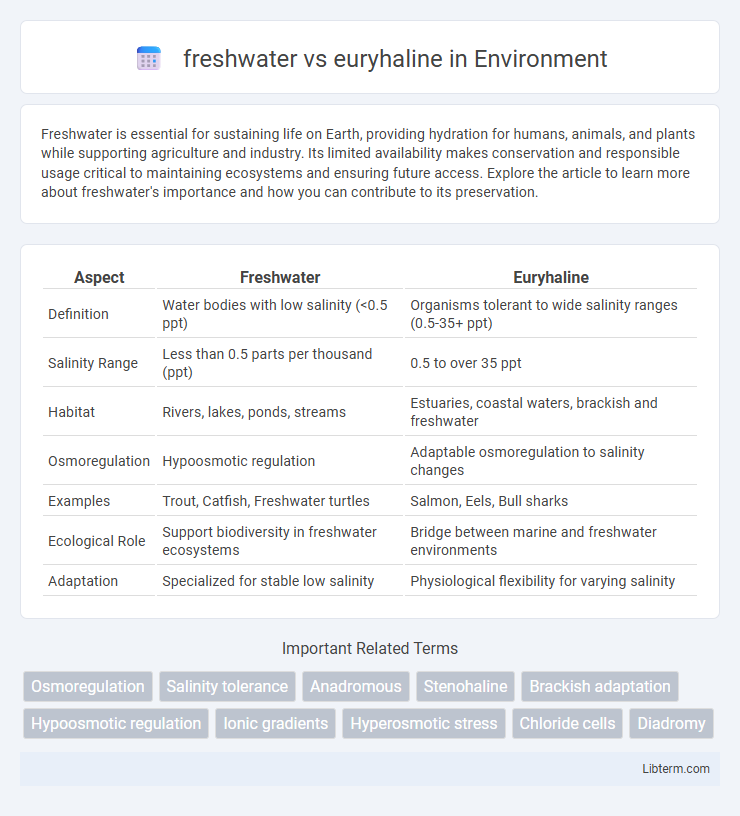Freshwater is essential for sustaining life on Earth, providing hydration for humans, animals, and plants while supporting agriculture and industry. Its limited availability makes conservation and responsible usage critical to maintaining ecosystems and ensuring future access. Explore the article to learn more about freshwater's importance and how you can contribute to its preservation.
Table of Comparison
| Aspect | Freshwater | Euryhaline |
|---|---|---|
| Definition | Water bodies with low salinity (<0.5 ppt) | Organisms tolerant to wide salinity ranges (0.5-35+ ppt) |
| Salinity Range | Less than 0.5 parts per thousand (ppt) | 0.5 to over 35 ppt |
| Habitat | Rivers, lakes, ponds, streams | Estuaries, coastal waters, brackish and freshwater |
| Osmoregulation | Hypoosmotic regulation | Adaptable osmoregulation to salinity changes |
| Examples | Trout, Catfish, Freshwater turtles | Salmon, Eels, Bull sharks |
| Ecological Role | Support biodiversity in freshwater ecosystems | Bridge between marine and freshwater environments |
| Adaptation | Specialized for stable low salinity | Physiological flexibility for varying salinity |
Introduction to Freshwater and Euryhaline Species
Freshwater species thrive in low-salinity environments, typically below 0.5 ppt, and have physiological adaptations to regulate internal salt concentrations. Euryhaline species possess the remarkable ability to tolerate a wide range of salinity levels, often transitioning between freshwater and marine habitats. These adaptations include osmoregulatory mechanisms that enable survival in diverse aquatic conditions, making euryhaline species vital for studying environmental salinity fluctuations and ecosystem connectivity.
Defining Freshwater Organisms
Freshwater organisms are species adapted to live in environments with low salinity, typically less than 0.5 parts per thousand, such as rivers, lakes, and streams. These organisms possess physiological mechanisms to maintain osmotic balance and prevent excessive water intake in hypotonic conditions. Unlike euryhaline species, which tolerate a wide range of salinities, freshwater organisms are specialized for stable low-salinity habitats.
What Are Euryhaline Species?
Euryhaline species are aquatic organisms capable of surviving in a wide range of salinities, including freshwater, brackish, and marine environments. Unlike strictly freshwater species, euryhaline animals possess physiological adaptations such as specialized osmoregulatory mechanisms that allow them to maintain homeostasis despite fluctuating salt concentrations. Common examples include species like the Atlantic salmon, which migrate between rivers and oceans, demonstrating remarkable salinity tolerance essential for lifecycle transitions.
Salinity Tolerance: Key Differences
Freshwater organisms thrive in environments with salinity levels typically below 0.5 ppt, requiring specialized adaptations to prevent excessive water intake and salt loss. Euryhaline species, such as certain fish and invertebrates, can tolerate a wide range of salinity from near 0 ppt up to 40 ppt or higher, enabling survival in both freshwater and marine habitats. This broad salinity tolerance is facilitated by efficient osmoregulatory mechanisms that maintain cellular ion balance across varying salinity gradients.
Physiological Adaptations for Survival
Freshwater fish maintain osmotic balance by actively absorbing salts through specialized gill cells and producing large volumes of dilute urine to prevent water overload. Euryhaline species exhibit remarkable physiological plasticity, switching ion transport mechanisms and modulating hormone levels, such as cortisol and prolactin, to survive in varying salinity conditions. These adaptations enable euryhaline fish to osmoregulate efficiently, maintaining homeostasis across both freshwater and marine environments.
Habitat Distribution and Ecosystem Roles
Freshwater species inhabit rivers, lakes, and streams with low salinity, playing crucial roles in nutrient cycling and supporting diverse aquatic food webs. Euryhaline species thrive in fluctuating salinity environments such as estuaries and coastal areas, contributing to ecosystem stability by bridging marine and freshwater habitats. Their unique adaptability allows them to regulate salinity balance, making them essential for maintaining biodiversity and ecosystem resilience in transitional zones.
Osmoregulation Mechanisms in Both Groups
Freshwater fish utilize active ion uptake and produce large volumes of dilute urine to prevent excessive water influx and maintain osmotic balance. Euryhaline fish possess flexible osmoregulatory mechanisms, allowing them to switch between ion absorption in freshwater and ion excretion in seawater via specialized chloride cells in their gills. These adaptations enable euryhaline species to regulate internal osmolarity efficiently across varying salinities, unlike strictly freshwater species with limited osmoregulatory plasticity.
Evolutionary Pathways and Genetic Adaptability
Freshwater fish have evolved specialized osmoregulatory mechanisms to maintain internal ion balance in low-salinity environments, reflecting long-term genetic adaptations to stable freshwater habitats. Euryhaline species possess versatile genetic traits that enable dynamic physiological adjustments to fluctuating salinity levels, resulting from evolutionary pathways favoring plasticity and resilience across diverse aquatic ecosystems. Comparative genomic studies reveal that euryhaline fish exhibit expanded gene families related to ion transport and stress response, illustrating their adaptive evolutionary strategies in contrast to freshwater-restricted lineages.
Examples of Freshwater and Euryhaline Species
Freshwater species like the largemouth bass (Micropterus salmoides) and the common carp (Cyprinus carpio) thrive exclusively in rivers, lakes, and streams with low salinity. Euryhaline species such as the Atlantic salmon (Salmo salar) and the molly fish (Poecilia spp.) can adapt to a wide range of salinities, moving between fresh and brackish or marine environments. This adaptability allows euryhaline species to exploit diverse habitats, unlike strictly freshwater species that require stable low-salinity conditions.
Conservation Implications and Environmental Challenges
Freshwater species, adapted to stable low-salinity environments, face heightened vulnerability from habitat fragmentation and pollution, necessitating targeted conservation strategies to maintain water quality and flow regimes. Euryhaline species, capable of tolerating varying salinities, encounter environmental challenges linked to fluctuating estuarine and coastal zones influenced by climate change and human activities such as dredging and saltwater intrusion. Conservation efforts must integrate habitat connectivity and resilience to salinity changes to safeguard biodiversity and ecosystem function in both freshwater and euryhaline habitats.
freshwater Infographic

 libterm.com
libterm.com